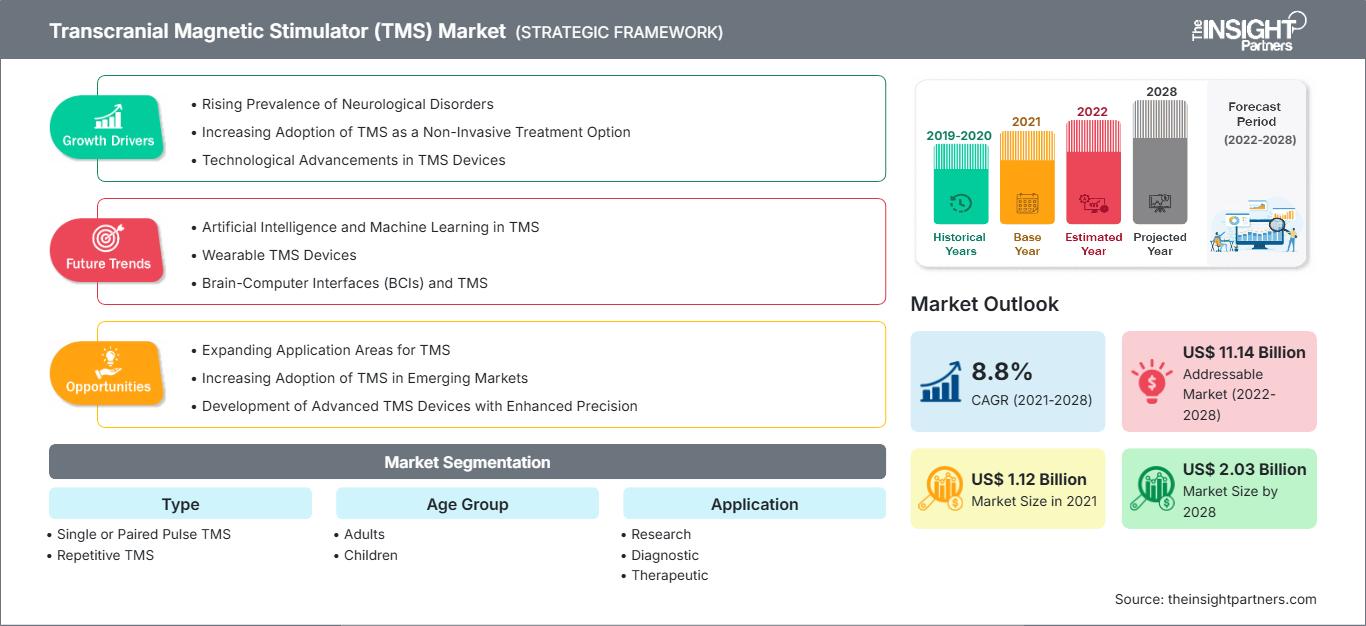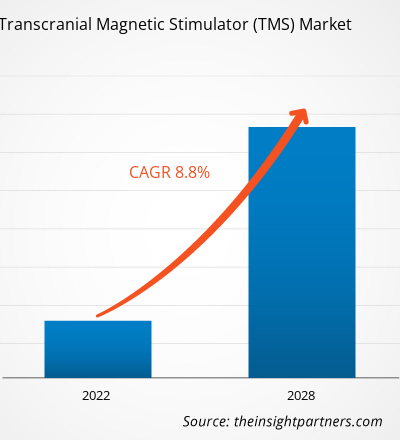Transcranial Magnetic Stimulator (TMS) Market Size and Competitive Analysis by 2028
Historic Data: 2019-2020 | Base Year: 2021 | Forecast Period: 2022-2028Transcranial Magnetic Stimulator (TMS) Market Forecast to 2028 - COVID-19 Impact and Global Analysis By Type (Single or Paired Pulse TMS, Repetitive TMS (rTMS)); Age Group (Adults, Children); Application (Research, Diagnostic, Therapeutic), and Geography
- Report Date : Aug 2021
- Report Code : TIPRE00007242
- Category : Life Sciences
- Status : Published
- Available Report Formats :


- No. of Pages : 152
[Research Report] The transcranial magnetic stimulator (TMS) market is projected to reach US$ 2,029.71 million by 2028 from US$ 1,122.22 million in 2021; it is expected to register a CAGR of 8.8% from 2021 to 2028.
Neurological disorders affect the brain and nerves of the human body and cause epilepsy and seizures, Parkinson's disease, dementia, autism, Alzheimer's disease, brain tumors, and cerebral palsy, among others. The prevalence of neurological disorders is increasing across the world. According to the Global Burden of Disease Study (GBD) 2017, Alzheimer’s disease and other dementias [2.55 million Disability Adjusted Life Years (DALYs)], stroke [about 3.58 million DALYs], and migraine (about 2.40 million DALYs) were the three most burdensome neurological diseases in the US in terms of a total number of disability-adjusted life.
Further, the Alzheimer's Association estimates that over 6 million Americans have Alzheimer's disease, and the number is projected to reach nearly 13 million by 2050. Transcranial Magnetic Stimulator (TMS) is widely used for the diagnosis and treatment of neurological disorders. For instance, according to BrainsWay Ltd., in April 2021, 100,000 patients across the world were treated with its Deep TMS. Thus, the growing prevalence of neurological disorders drives the growth of the transcranial magnetic stimulator (TMS) market globally. Moreover, depression is one of the mental disorders observed commonly among people worldwide. As per the data published by WHO in January 2020, more than 264 million people of all ages suffer from depression across the world.
Customize This Report To Suit Your Requirement
You will get customization on any report - free of charge - including parts of this report, or country-level analysis, Excel Data pack, as well as avail great offers and discounts for start-ups & universities
Transcranial Magnetic Stimulator (TMS) Market: Strategic Insights

-
Get Top Key Market Trends of this report.This FREE sample will include data analysis, ranging from market trends to estimates and forecasts.
Market Insights
Transcranial magnetic stimulation (TMS) is a noninvasive procedure that helps in treating neurological disorders. In addition, growing technological developments in TMS have increased its applications. Companies operating in the transcranial magnetic stimulator (TMS) market are adopting various strategies such as receiving Food and Drug Administration (FDA) approvals for their innovative products, business partnerships, and raising funds for product development, which propel the market growth.
The following are a few examples of developments:
- In March 2021, MagVenture introduced the MagVenture Flow Arm—a patent-pending, clinical positioning system—designed to optimize the delivery of MagVenture's FDA-cleared protocols for noninvasive brain stimulation technology for the treatment of major depressive disorder and as an adjunct therapy for obsessive compulsive disorder (OCD).
- In August 2020, MagVenture TMS Therapy received FDA clearance for the adjunct treatment of OCD. It is the second indication in the US for the Danish medical device company MagVenture.
- In February 2019, eNeura, Inc., a privately held medical technology company, announced a new 510(k) clearance from FDA. With the clearance, the company claimed that the sTMS is the only migraine product in the US for the treatment of acute and prophylactic migraine headaches in adults and children (12 years and above).
Thus, the active involvement of the global players in the development of transcranial magnetic stimulation and related technologies is expected to support the market growth.
Type-Based Insights
Based on type, the transcranial magnetic stimulator (TMS) market is segmented into single or paired pulse TMS and repetitive TMS (rTMS). In 2021, the single or paired pulse TMS segment held a larger share of the market. However, the repetitive TMS (rTMS) segment is expected to witness a higher CAGR during 2021–2028.
Application-Based Insights
Based on application, the market is segmented into research, diagnostic, and therapeutic. In 2021, the diagnostic segment held the largest share of the market and is expected to grow at the highest CAGR during the coming years.
Companies operating in the transcranial magnetic stimulator (TMS) market emphasize on adopting the strategy of product innovations to meet the evolving customer demands across the world, which also permits them to maintain their brand name in the global market.
Transcranial Magnetic Stimulator
Transcranial Magnetic Stimulator (TMS) Market Regional InsightsThe regional trends and factors influencing the Transcranial Magnetic Stimulator (TMS) Market throughout the forecast period have been thoroughly explained by the analysts at The Insight Partners. This section also discusses Transcranial Magnetic Stimulator (TMS) Market segments and geography across North America, Europe, Asia Pacific, Middle East and Africa, and South and Central America.
Transcranial Magnetic Stimulator (TMS) Market Report Scope
| Report Attribute | Details |
|---|---|
| Market size in 2021 | US$ 1.12 Billion |
| Market Size by 2028 | US$ 2.03 Billion |
| Global CAGR (2021 - 2028) | 8.8% |
| Historical Data | 2019-2020 |
| Forecast period | 2022-2028 |
| Segments Covered |
By Type
|
| Regions and Countries Covered |
North America
|
| Market leaders and key company profiles |
|
Transcranial Magnetic Stimulator (TMS) Market Players Density: Understanding Its Impact on Business Dynamics
The Transcranial Magnetic Stimulator (TMS) Market is growing rapidly, driven by increasing end-user demand due to factors such as evolving consumer preferences, technological advancements, and greater awareness of the product's benefits. As demand rises, businesses are expanding their offerings, innovating to meet consumer needs, and capitalizing on emerging trends, which further fuels market growth.

- Get the Transcranial Magnetic Stimulator (TMS) Market top key players overview
Transcranial Magnetic Stimulator (TMS) Market – Segmentation
By Type
- Single or Paired Pulse TMS
- Repetitive TMS (rTMS)
By Age Group
- Adults
- Children
By Application
- Research
- Diagnostic
- Therapeutic
By Geography
- North America
- US
- Canada
- Mexico
- Europe
- France
- Germany
- Italy
- UK
- Spain
- Rest of Europe
- Asia Pacific (APAC)
- China
- India
- South Korea
- Japan
- Australia
- Rest of APAC
- Middle East and Africa (MEA)
- South Africa
- Saudi Arabia
- UAE
- Rest of MEA
- South and Central America (SCAM)
- Brazil
- Argentina
- Rest of SCAM
Company Profiles
- BrainsWay Ltd
- Nexstim, Magstim
- Neuronetics
- TMS Neuro Solutions
- MagVenture, Inc.
- eNeura Inc.
- Neurosoft
- MAG & More GmbH
Frequently Asked Questions
Which region is the fastest growing the Transcranial Magnetic Stimulator (TMS) market?
Which segment is dominating the Transcranial Magnetic Stimulator (TMS) market?
Who are the major players in the Transcranial Magnetic Stimulator (TMS) market?
Which country is dominated the Transcranial Magnetic Stimulator (TMS) market?
What are the driving factors for the Transcranial Magnetic Stimulator (TMS) market across the globe?
What is Transcranial Magnetic Stimulator (TMS)?
Mrinal is a seasoned research analyst with over 8 years of experience in Life Sciences Market Intelligence and Consulting. With a strategic mindset and unwavering commitment to excellence, she has built deep expertise in pharmaceutical forecasting, market opportunity assessment, and developing industry benchmarks. Her work is anchored in delivering actionable insights that empower clients to make informed strategic decisions.
Mrinal’s core strength lies in translating complex quantitative datasets into meaningful business intelligence. Her analytical acumen is instrumental in shaping go-to-market (GTM) strategies and uncovering growth opportunities across the pharmaceutical and medical device sectors. As a trusted consultant, she consistently focuses on streamlining workflow processes and establishing best practices, thereby driving innovation and operational efficiency for her clients.
- Historical Analysis (2 Years), Base Year, Forecast (7 Years) with CAGR
- PEST and SWOT Analysis
- Market Size Value / Volume - Global, Regional, Country
- Industry and Competitive Landscape
- Excel Dataset
Recent Reports
Testimonials
The Insight Partners' SCADA System Market report is comprehensive, with valuable insights on current trends and future forecasts. The team was highly professional, responsive, and supportive throughout. We are very satisfied and highly recommend their services.
RAN KEDEM Partner, Reali Technologies LTDsI requested a report on a very specific software market and the team produced the report in a few days. The information was very relevant and well presented. I then requested some changes and additions to the report. The team was again very responsive and I got the final report in less than a week.
JEAN-HERVE JENN Chairman, Future AnalyticaWe worked with The Insight Partners for an important market study and forecast. They gave us clear insights into opportunities and risks, which helped shape our plans. Their research was easy to use and based on solid data. It helped us make smart, confident decisions. We highly recommend them.
PIYUSH NAGPAL Sr. Vice President, High Beam GlobalThe Insight Partners delivered insightful, well-structured market research with strong domain expertise. Their team was professional and responsive throughout. The user-friendly website made accessing industry reports seamless. We highly recommend them for reliable, high-quality research services
YUKIHIKO ADACHI CEO, Deep Blue, LLC.This is the first time I have purchased a market report from The Insight Partners.While I was unsure at first, I visited their web site and felt more comfortable to take the risk and purchase a market report.I am completely satisfied with the quality of the report and customer service. I had several questions and comments with the initial report, but after a couple of dialogs over email with their analyst I believe I have a report that I can use as input to our strategic planning process.Thank you so much for taking the extra time and making this a positive experience.I will definitely recommend your service to others and you will be my first call when we need further market data.
JOHN SUZUKI President and Chief Executive Officer, Board Director, BK TechnologiesI wish to appreciate your support and the professionalism you displayed in the course of attending to my request for information regarding to infectious disease IVD market in Nigeria. I appreciate your patience, your guidance, and the fact that you were willing to offer a discount, which eventually made it possible for us to close a deal. I look forward to engaging The Insight Partners in the future, all thanks to the impression you have created in me as a result of this first encounter.
DR CHIJIOKE ONYIA MANAGING DIRECTOR, PineCrest Healthcare Ltd.Reason to Buy
- Informed Decision-Making
- Understanding Market Dynamics
- Competitive Analysis
- Identifying Emerging Markets
- Customer Insights
- Market Forecasts
- Risk Mitigation
- Boosting Operational Efficiency
- Strategic Planning
- Investment Justification
- Tracking Industry Innovations
- Aligning with Regulatory Trends




















 Get Free Sample For
Get Free Sample For